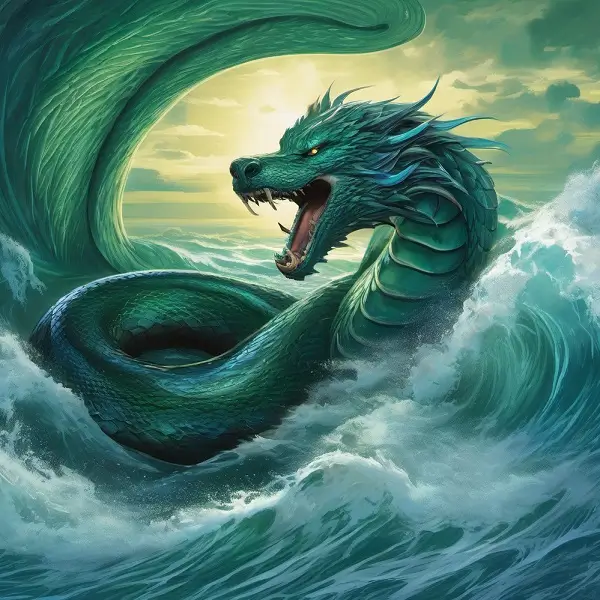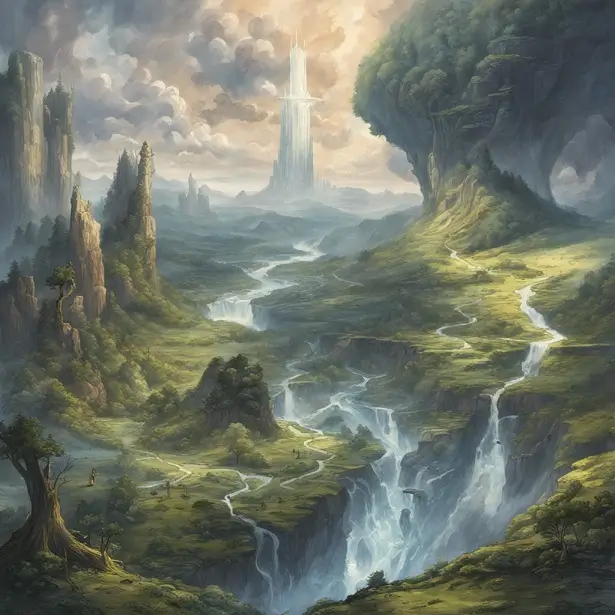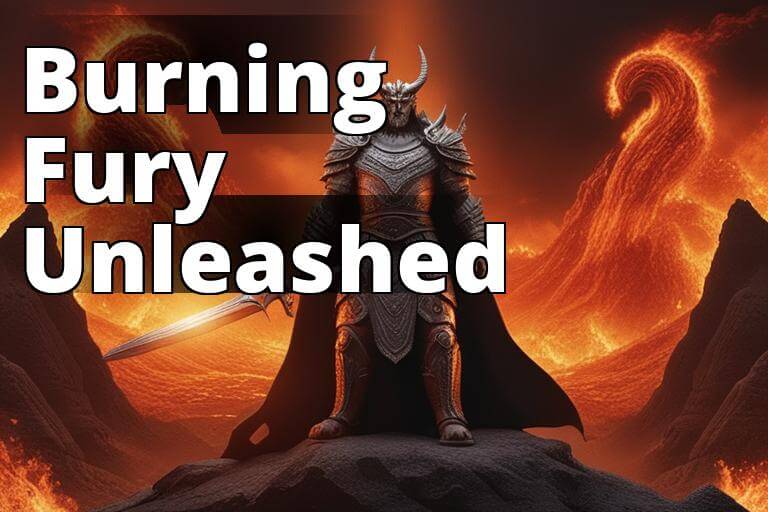Eikthyrnir is a fascinating creature that features prominently in Norse mythology. Described as a mystical stag of unparalleled beauty and significance, is associated with a range of themes in Norse legends, from fertility and abundance to the afterlife and cosmic balance.
This article will provide a comprehensive overview of Eikthyrnir, exploring its origins, physical appearance, deeper symbolism, role in Norse mythology, cultural significance, and enduring popularity in modern pop culture.
Eikthyrnir: Origins and Role
Eikthyrnir, whose name means “oak-thorny” or “oak thorn stag” in Old Norse, has its roots in early Norse mythology and folklore.
Scholar Anatoly Liberman suggests the name was formed by splitting Heiðþyrnir, the lowest heaven in Norse mythology, into Eikthyrnir and Heiðrún—the goat who resides alongside Eikthyrnir atop Valhalla. The association with thorns likely arose from folk etymology.
The stag is said to originate from ancient Norse belief systems, where it represented concepts like fertility, rebirth, growth, and renewal.
According to Norse legends, Eikthyrnir resides on the roof of Valhalla, the enormous hall presided over by Odin where fallen warriors go after death.
Valhalla is depicted as a majestic hall roofed with shields and spear shafts and rafters adorned with armor. Here the slain warriors eat and drink to their heart’s content, being catered by the Valkyries.
At Valhalla, Eikthyrnir stands tall on the roof and draws nourishment from Laeradr, the highest branch of Yggdrasil, the great ash tree that interconnects the nine worlds of Norse cosmology.
Yggdrasil’s roots are said to feed Eikthyrnir’s antlers with mystical energy and sacred waters from the Well of Urðr, which flows beneath the tree’s massive roots.
The tree and the well represent the cycle of life in Norse myths. Eikthyrnir’s feeding on the tree and drinking from the well symbolize renewal, fertility, and eternal life.
This ability to draw sustenance from Yggdrasil and produce mead endows Eikthyrnir with qualities of abundance and importance in the Norse pantheon.
As a resident of Valhalla’s roof, Eikthyrnir also has connections to Odin, the most revered Norse god and the ruler of Valhalla. This prominent positioning indicates Eikthyrnir’s stature among the gods and its role of guiding fallen warriors to the afterlife.
Physical Appearance and Symbolism
Eikthyrnir is described in Norse legends as the most beautiful creature in existence. It has a stunning appearance, with intricate antlers spreading out like branches of a tree and a lustrous, golden coat.

Its antlers are compared to the boughs of Yggdrasill, representing Eikthyrnir’s connection to the different worlds and realms linked by the cosmic tree. The antlers also symbolize growth and fertility.
The rich, golden hue of Eikthyrnir’s coat represents purity, strength, and eternal youth in Norse symbolism. This ties into the stag’s connection with Valhalla, where fallen warriors are restored to permanent youth and vigor.
Overall, every aspect of Eikthyrnir’s striking appearance seems to reflect broader symbolic themes in Norse mythology related to the afterlife, connectivity, spiritual guidance, and the concept of rebirth after death.
Role in Norse Mythology
Eikthyrnir features prominently in several Norse myths and legends. One of its most well-known appearances is in the Old Norse poem Grímnismál ver 26 (Song of Grimner) from the Poetic Edda.
Eikþyrnir heitir hjörtr,
er stendr á höllo Herjaföðrs
ok bítr af Læraðs limom;
en af hans hornom
drýpr i Hvergelmi,
þaðan eigo vötn öll vega.
Eikthyrnir is the hart | who stands by Heerfather’s hall
And the branches of Lærath he bites;
From his horns a stream | into Hvergelmir drops,
Thence all the rivers run.
In this account, Eikthyrnir is described as standing by Valhalla and feeding on the branches and leaves of the tree Læraðr. As the stag chews on the foliage, liquid drips from its antlers down into Hvergelmir, the bubbling spring located beneath one of Yggdrasil’s three main roots. The spring Hvergelmir then gives rise to countless mythical rivers.
This scene establishes Eikthyrnir’s role in Norse cosmology as a life-giving force whose antlers provide the spark from which originates the source of all water in the primordial worlds.
Snorri, while not explicitly quoting the Grímnismál stanza, takes up its elements and quotes much of the river names in the poem:
Edda in prosa > Gylfaginning [39]
Enn er meira mark at of hjörtinn Eirþyrni, er stendr á Valhöll ok bítr af limum þess trés, en af hornum hans verðr svá mikill dropi at niðr kemr í Hvergelmi, en þaðan af falla ár þær er svá heita: Síð, Víð, Sekin, Ekin, Svöl, Gunnþró, Fjörm, Fimbulþul, Gipul, Göpul, Gömul, Geirvimul, þessar falla um ásabygðir. Þessar eru enn nefndar: Þyn, Vin, Þöll, Böll, Gráð, Gunnþráin, Nýt, Nöt, Nönn, Hrönn, Vína, Veg, Svinn, Þjóðnuma.
Even more remarkable is the deer Eikþyrnir: he too is found in Valhöll and grazes the branches of the tree [Léraðr]. From its horns drip many drops that fall into Hvergelmir, and from here arise the rivers thus named: Síð, Víð, Sekin, Ekin, Svöl, Gunnþrá, Fjörm, Fimbulþul, Gipul, Göpul, Gömul, Geirvimul. The latter flow around the abode of the Æsir. Still counted are these: Þyn, Vin, Þöll, Höll, Gráð, Gunnþráin, Nýt, Nöt, Nönn, Hrönn, Vína, Vegsvinn, Þjóðnuma.
The paragraph provides rich detail about Eikthyrnir’s role and adds to the sense of the interconnectedness of the Norse mythological world. The stag’s location atop Valhalla and his sustenance from Yggdrasil highlight his symbolic importance.
The rivers flowing from the stag’s antlers to nourish the realms further emphasize the ideas of renewal and sustenance associated with Eikthyrnir.
The stag draws life from Yggdrasil, and in turn, provides sustenance to the inhabitants of Asgard through the mead dripping from its antlers. It serves as a bridge between the mortal and divine realms.

In the poem Hávamál, Eikthyrnir is mentioned as one of the creatures living in Yggdrasil, further highlighting its central role in Norse mythology.
The goat, known as Heidrun in Old Norse as Heiðrún, grazes on the tree’s leaves throughout the day. In contrast, the stag, named Eikthyrnir, devotes its time to feasting on the fresh cuttings from the tree.
The stag also appears briefly in the story of Thor and the giant Hymir, where it is described as one of the animals harnessed by Hymir to pull his boat. This emphasizes Eikthyrnir’s association with supernatural strength and stature.
Eikthyrnir holds great symbolic importance in Norse mythology:
- The stag’s antlers represent growth and fertility, like the perpetually growing branches of Yggdrasil.
- Its lustrous golden coat symbolizes purity, nobility and vigor, reflecting the idealized state of warriors in the afterlife.
- Drawing sustenance from Yggdrasil and the Well of Urðr associates Eikthyrnir with concepts like renewal, abundance and the continuity of life.
- Residing in Valhalla links the stag to guidance, protection and safe passage to the world of the honored dead.
- Serving as a bridge between the Well of Urðr, Yggdrasil and Valhalla, Eikthyrnir connects the mortal and divine realms.
Role in Norse Myths:
Eikthyrnir plays a key role in several Norse tales:
- In the poem Grímnismál, the stag feeds on Yggdrasil’s branches and through its antlers drips liquid into the spring Hvergelmir, giving rise to rivers that flow through the Nine Worlds.
- In Hávamál and other texts, Eikthyrnir is mentioned as one of the animals that lives in Yggdrasil, tending to the World Tree.
- In the myth of Thor and Hymir, Eikthyrnir is described as having the supernatural strength to help tow the giant Hymir’s boat.
Associations & Relationships
Beyond his origins and myths, Eikthyrnir boasts rich associations and relationships with gods, creatures, and places:
- Yggdrasil – As a resident of the World Tree, Eikthyrnir symbolizes the web of destiny and life energy flowing through the Nine Worlds.
- Odin – By producing mead dripped from his antlers, Eikthyrnir supplies the drink of poetic inspiration craved by the chief god Odin.
- Sif – Eikthyrnir’s bountiful antlers associate him with Sif, the fertility goddess tied to harvest and the earth’s renewal.
- Heiðrún – As a fellow resident of topmost Yggdrasil, the she-goat Heiðrún pairs with Eikthyrnir in art and myth.
- Valkyries – These female war deities gather the mead streaming from Eikthyrnir’s antlers down to Odin’s hall.
- Huginn & Muninn – Odin’s raven companions are said to ride upon Eikthyrnir’s antlers to gather mead for their master.
- Níðhöggr – The serpent Níðhöggr threatens Eikthyrnir by gnawing at Yggdrasil’s roots beneath them.

Nidhogg
These rich relationships reinforce Eikthyrnir’s expansive symbolic ties to prophecy, wisdom, sustenance, and the delicate balance of the cosmos.
Cultural Significance & Worship
As a bringer of bounty and grace, Eikthyrnir held deep cultural meaning for ancient Norse and Germanic peoples:
- Fertility Symbol – The stag’s antlers and Yggdrasil associations made him an emblem of vitality, fertility, and the annual renewal of the seasons.
- Religious Practice – Some scholars propose cultic religious practices venerating stags, potentially involving sacrificing them to gain their divine life force.
- Funerary Rites – Eikthyrnir’s horns were incorporated into burial ceremonies, alluding to the stag as a psychopomp guide to the afterlife.
- Runic Inscriptions – Images and references to Eikthyrnir appear on various archaeological artifacts and rune stones across Scandinavia.
- Artistic Motif – Eikthyrnir commonly appears in metalwork, jewelry, and decorative items from the Viking Age, affirming his cultural renown.
- Mead Culture – The mead Eikthyrnir supplies from his antlers bore deep social significance, used to seal oaths, sacrifices, and important occasions.
This rich cultural presence affirms Eikthyrnir’s standing as a key symbol with deep roots in Norse spirituality, society, and customs.
Modern Day Pop Culture
Thanks to renewed interest in Norse mythology, Eikthyrnir has gained a significant pop culture presence in modern times.
- Literature – In J.R.R. Tolkien’s Lord of the Rings, an image of a white stag appears as the emblem for Legolas, likely inspired by Eikthyrnir.
- Gaming – Eikthyrnir appears in God of War (2018) and Assassin’s Creed: Valhalla (2020) as an interactive character aiding the protagonist.
- Television – The stag makes an appearance in the Vikings TV series, demonstrating the show’s emphasis on Norse legendary creatures.
- Neopaganism – Modern adherents of Norse Paganism continue to extol Eikthyrnir as a symbol of the life force and the embodiment of vitality.
- Contemporary Art – Eikthyrnir and related Norse creatures feature heavily in works by artists like Arthur Rackham, bearing the stag’s onward appeal.
Though centuries have passed since the height of ancient Norse culture, Eikthyrnir’s symbolic potency and dramatic mystique continue to capture creative minds and popular interest.
FAQ
Who is Eikthyrnir in Norse mythology?
Eikthyrnir is a mythical stag who resides atop the hall of Valhalla in Norse mythology. He is a key creature in several Norse legends.
What is the meaning and origin of Eikthyrnir’s name?
The name Eikthyrnir derives from the Old Norse words for “oak” (eik) and “thorny” (thyrnir), referring to his antlers resembling oak branches.
How is Eikthyrnir described physically in the myths?
Eikthyrnir is described as a grand stag with golden fur and intricate, robust antlers akin to spreading oak branches.
What is Eikthyrnir’s role and significance in Norse legends?
Across Norse myths, Eikthyrnir represents renewal, wisdom, and the interconnectedness of realms through his ties to Yggdrasil and production of mystical mead.
What key associations does Eikthyrnir have with other Norse entities?
Eikthyrnir shares vital associations with Odin, Sif, Heiðrún, Valkyries, Huginn and Muninn, Yggdrasil, and more, underscoring his symbolic importance.
How was Eikthyrnir culturally significant for ancient Norse peoples?
Eikthyrnir was an emblem of fertility, prominence in funerary rites, and mead culture, demonstrating his pervasive presence in Norse society.
Where does Eikthyrnir appear in modern pop culture and creative works?
Eikthyrnir appears in media like God of War, Vikings, Tolkien’s Legendarium, and Neopagan art, showcasing his enduring mythical appeal.
What is the key takeaway about Eikthyrnir?
As a radiant stag associated with cosmic forces, Eikthyrnir stands out as one of the most poignant mythical creatures in Norse legends.
Conclusion
As one of the most iconic creatures in Norse mythology, the mystical stag Eikthyrnir has captivated minds across centuries.
With origins tied to ancient Norse texts like the Poetic Edda, Eikthyrnir’s symbolic meanings and relationships touch upon fundamental aspects of life, destiny, wisdom, and the afterlife within Norse culture.
Eikthyrnir’s central role across formative Norse myths solidifies his position interwoven with Odin, Yggdrasil, and existential forces underpinning reality.
The stag’s bountiful associations with vitality and renewal made him a profound cultural emblem among ancient Norse societies. Today, popular media and creative works affirm Eikthyrnir’s enduring legend across literature, games, art, and religious practice.
For his vast mythic resonance, profound symbolism, and perennial appeal, the radiant stag Eikthyrnir stands tall as a supreme fixture of Norse lore.
Shop Norse Jewelry
Are passionate about Norse Mythology?
Finding the ideal piece of Norse Jewelry can be challenging and time-consuming, especially if you lack inspiration or don’t know where to look.
Surflegacy, has you covered. We have a wide range of Handmade Jewelry in various styles, shapes, colors, and materials, to accentuate your Norse spirit and look. Do not hesitate to visit our selection HERE
Whatever you wear, you’ll find the ideal trendy piece to complement your wardrobe. Our jewelry is designed to be worn every day, no matter where you go or what season is. Are you ready to step up your wardrobe game?
















